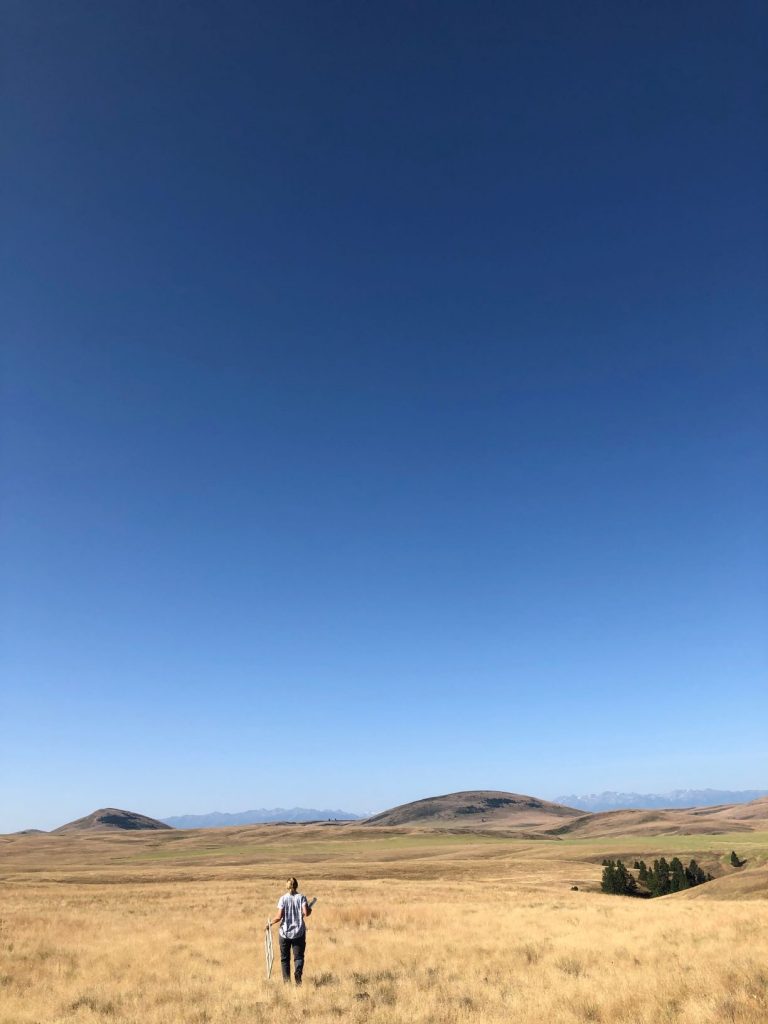
This past week I went to the Zumwalt with Dr. DeBano, Scott and James. We worked on the final sets of pan traps, plant sampling, and some minor soil sampling. On Friday, I joined Dr. DeBano and Scott at Starkey, where I helped Dr. DeBano with plant sampling while Scott hand netted bees and identified willows.

We arrived at Summer Camp around 3pm on Monday. Thankfully, the weather felt more like September than high summer, as temperatures hovered around 75 to 80 the entire week! While the breeze was occasionally stale, it felt like a gift compared to the previous summer. After getting settled at camp we began setting out pan traps. The pan traps are placed along the backbone of each transect, and are collected after 48 hours. The traps are small containers painted with either yellow, white, or blue fluorescent paint and are filled with soapy water. We set out 10 sets of the 30 traps on the first day.
On Tuesday, I partnered up with Dr. DeBano on plant sampling and quadrants. I was the scribe, and as such got to record the various types and amounts of blooming plants found along each transect. It is the same data I have been entering for the last few weeks with Kaylee. I actually found it really enjoyable, since it helped reinforce my plant identification, and well…I like flowers. It was also interesting to see the difference between grazed and ungrazed sites, or burned and unburned sites. Most of what’s blooming is still Achillea millefolium, Pieride gardenii, and Erigeron corymbosus.

As for the quadrant work I recorded the percentage of grass, bare ground, biological soil crust, feces, rock, or forbs within each sample. The goal is to have the total equal to 100%. For instance, a sample could comprise of 25% forbs, 25% bare ground, and 50% grass. Dr. DeBano makes the estimates on all quadrants and transect sampling to avoid any bias. The quadrant is thrown about a meter from each whisker on the same transects we collect all the other data on. She avoids looking at where she throws the quadrant, so that she can eliminate any further bias.

On Tuesday Scott and James witnessed quite the predator prey interaction. They described seeing a massive herd of elk near Harsin Butte acting strangely. The elk began panicking, bugling and separating. Scott and James then said they saw several canine figures below the herd. They’re fairly certain, due to the size and behavior of all parities involved, that they were watching a pack of wolves. Jealous is an understatement.

On Wednesday, Scott and I drove to The Nature Conservancy office in Enterprise to pick up a spare penetrometer. We then went out to a few sites and measured soil compaction on obvious cow trails, then one and two meters off the trails. We also measured soil compaction on Patti’s trail; which is a popular hiking trail near Harsin Butte. Scott was curious to see if there were any patterns from foot, and hoof, traffic at the sites. Around 3pm we then worked on collecting Monday’s pan traps. We did however, get side tracked when we saw a large plume of smoke on the horizon. We drove up to Monument to get a better vantage point of the fire and to get cell service to call in the brush fire. Shortly after, we noticed a large amount of smoke coming from the Wallowa Mountains. The larger fire near the mountains turned out to be the Granite Gulch Fire near Union. I went hiking Sunday in the Eagle Cap Wilderness and saw a large fire pop off within a drainage. Low and behold, it was the Granite Gulch Fire. I live about 10 miles from the 2,000+ acre fire, and it’s been exciting to see it transform over the last few days.

Since the fire frenzy set us back at least a hour, Scott and I had to work until we could no longer see. It’s important to keep the data uniform, and so we needed to collect the last two sites of pan traps. Unfortunately, we ran out of time and had to give up on the last sets. We decided to retrieve them early the next morning and just made note of the added two hours of daylight. We did, however, get to see another phenomenal sunset while looking for the little pink and yellow whiskers hidden between all the bunchgrass. The clouds once again transformed from a cool gray, to magenta, to a soft violet.

This past week I also decided to camp in the field behind Summer Camp. The last several field trips I’ve opted to sleep inside the Doctor’s Cabin as it was pretty hot out and the whole house was available. I’m honestly a little embarrassed to admit that the sound of coyotes yapping generally sends shivers down my spine. But since reading more about them in my free time this summer, and just generally seeing them more since working on the prairie, I’ve become more tolerant of the sound. It was finally enjoyable, or at least comforting to hear their sounds from all directions while I was going to sleep. It served as a reminder that I’m sharing this space. The cackling coyotes have transitioned from a warning sign to one of comfort: in that it tells me the prairie is a thriving, healthy habitat.
The next two days we worked on picking up the remaining pan traps, and then picking up all the whiskers and flagging from the field season. This upcoming week I will be joining Scott on Tuesday and Wednesday on the Zumwalt, where we will be working with the emergence traps. The rest of the week will be spent working on data entry back in La Grande.

